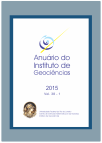Morphology and Genesis of Microbially Induced Sedimentary Structures (MISS) in Sediments of the Lagoa Vermelha (Região dos Lagos -- Rio de Janeiro)
DOI:
https://doi.org/10.11137/2015_1_95_106Keywords:
MISS, Lagoa Vermelha, Carbonate sedimentationAbstract
MISS are primary sedimentary structures formed by interactions between biofilms and microbial mats with physical and chemical dynamics of sediments. Recognizing these structures in the geologic record are difficult because there are no criteria of identification, and sometimes they can be confused with other depositional or erosional physical structures. During the last decades, lots of biological, mineralogical, geochemicals and isotopic studies related to stromatolites and microbial mats were performed in the Lagoa Vermelha. However, the sedimentary structures formed by microbial induction (MISS) have never been the subject of these studies. The aim of this study is the description and characterization of MISS that occur in sediments of the Lagoa Vermelha, and recognize the main biosedimentological factors involved on their genesis. MISS were recognized macroscopically in the field and cores. The main processes recognized are microbial growth (that form laminated leveling structures), bioestabilization (that form desiccation cracks, mat curls, mat chips), metabolism (that form biolaminite, stromatolite, biscuit stromatolite, thrombolytic nodule) and binding, baffling & trapping. The combination of processes can also produce structures (wrinkles, detachment structure, petees). Petrographic analysis supported the identification of binding, baffling & trapping processes and others microscopic microbial features. The results allow a better understanding of the relationship between microbial mats and physical and chemical processes in a lagoon sedimentary environment. The recognition of these structures formed by microbial induction in modern environments helps their recognition in the geologic record of continental and marine successions.Downloads
Download data is not yet available.
Downloads
Published
2017-02-15
How to Cite
Sampaio, L. da F., Dal' Bó, P. F. F. and Borghi, L. (2017) “Morphology and Genesis of Microbially Induced Sedimentary Structures (MISS) in Sediments of the Lagoa Vermelha (Região dos Lagos -- Rio de Janeiro)”, Anuário do Instituto de Geociências. Rio de Janeiro, BR, 38(1), pp. 95–106. doi: 10.11137/2015_1_95_106.
Issue
Section
Article
License
This journal is licensed under a Creative Commons — Attribution 4.0 International — CC BY 4.0, which permits use, distribution and reproduction in any medium, provided the original work is properly cited.















